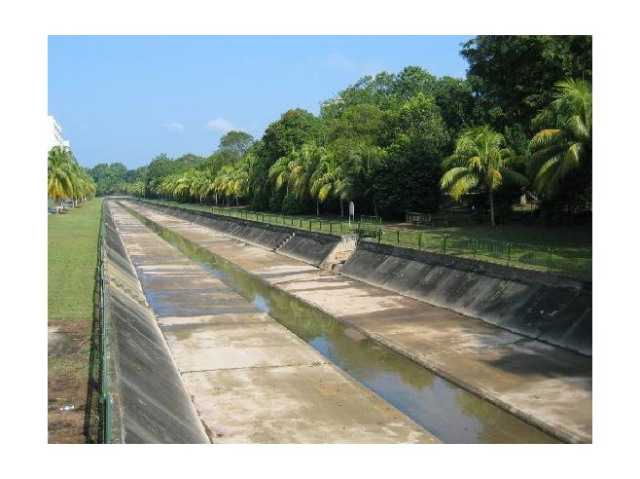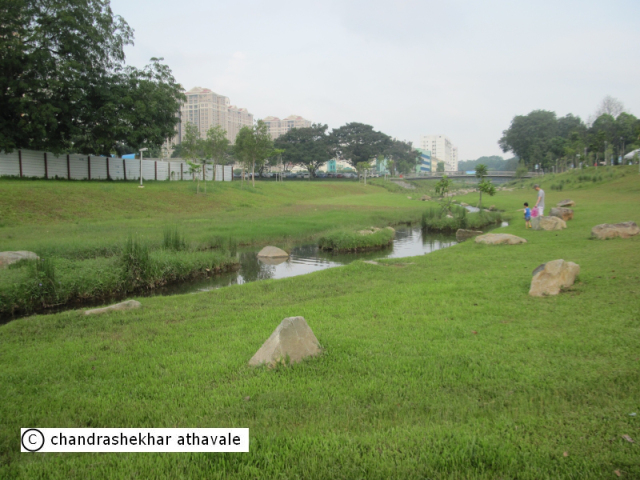Streambed (or riverbed) represents the floor of the river, including each riverbank. In the past, riverbeds were artificially reconstructed with concrete or big stones, therefore modifying flows and decreasing fauna habitat and vegetation diversity. Those modifications were aiming at flood prevention or supporting changes of agricultural practices for example. This has led to uniformed flows in the rivers and often having effect of reducing travel time along the river. Streambed re-naturalization consists in removing some concrete or inert constructions in the riverbed and on riverbanks, then replacing them with vegetation structures, in order to avoid these damages and restore biodiversity.
The re-naturalization of river beds and banks could have a high impact on the erosion process. Stabilisation techniques are among the main measures to be implemented. The maximum impact is reached when the stabilisation technique restores the vegetation cover and the naturalness of the banks. Most of the time, techniques use plants for bank stabilization. According to their degree of complexity, these techniques can be grouped into two categories:
- bank re-naturalization
- plant engineering
Bank re-naturalization is a stabilisation technique used to correct mild erosion problems and that does not require a high degree of expertise to be implemented.
Plant engineering is defined as the techniques combining the principles of ecology and engineering to design and implement slope, bank and bank stabilisation works, using plants as raw materials for making vegetable frames.
 |
 |
|
River before renaturalization |
River after renaturalization |
| Benefits | Level |
|---|---|
|
BP3 - Store river water
|
Medium
|
|
BP4 - Slow river water
|
High
|
|
BP5 - Increase evapotranspiration
|
Low
|
|
BP6 - Increase infiltration and/or groundwater recharge
|
High
|
|
BP7 - Increase soil water retention
|
Low
|
|
BP9 - Intercept pollution pathways
|
Medium
|
|
BP10 - Reduce erosion and/or sediment delivery
|
High
|
|
BP11 - Improve soils
|
Medium
|
|
BP12 - Create aquatic habitat
|
High
|
|
BP13 - Create riparian habitat
|
High
|
|
BP14 - Create terrestrial habitats
|
Low
|
|
BP16 - Reduce peak temperature
|
Medium
|
|
BP17 - Absorb and/or retain CO2
|
Low
|
|
ES1 - Water storage
|
Low
|
|
ES2 - Fish stocks and recruiting
|
Low
|
|
ES3 - Natural biomass production
|
Medium
|
|
ES4 - Biodiversity preservation
|
High
|
|
ES6 - Groundwater/aquifer recharge
|
Low
|
|
ES7 - Flood risk reduction
|
Medium
|
|
ES8 - Erosion/sediment control
|
High
|
|
ES9 - Filtration of pollutants
|
Medium
|
|
ES10 - Recreational opportunities
|
Medium
|
|
ES11 - Aesthetic/cultural value
|
Medium
|
|
PO1 - Improving status of biology quality elements
|
High
|
|
PO2 - Improving status of physico-chemical quality elements
|
Low
|
|
PO3 - Improving status of hydromorphology quality elements
|
Medium
|
|
PO4 - Improving chemical status and priority substances
|
Medium
|
|
PO5 - Improving quantitative status
|
Low
|
|
PO6 - Improving chemical status
|
Low
|
|
PO7 - Prevent surface water status deterioration
|
Medium
|
|
PO8 - Prevent groundwater status deterioration
|
Medium
|
|
PO9 - Take adequate and co-ordinated measures to reduce flood risks
|
Medium
|
|
PO10 - Protection of important habitats
|
High
|
|
PO11 - Better protection for ecosystems and more use of Green Infrastructure
|
High
|
|
PO13 - Better management of fish stocks
|
High
|
|
PO14 - Prevention of biodiversity loss
|
High
|
